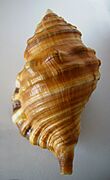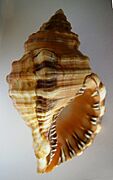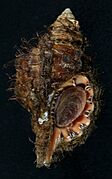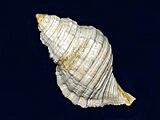Monoplex parthenopeus facts for kids
Quick facts for kids Monoplex parthenopeus |
|
|---|---|
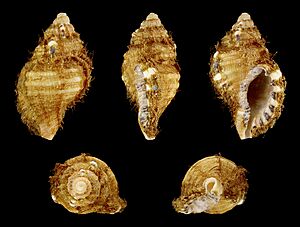 |
|
| Apertural view of Monoplex parthenopeus | |
| Conservation status | |
| Scientific classification |
The Monoplex parthenopeus, also known as the giant triton or giant hairy triton, is a type of large sea snail. It's a marine gastropod mollusk that belongs to the family Cymatiidae. These snails are known for hunting and eating other mollusks.
Contents
Ancient Discoveries: Fossil Records
Scientists have found fossils of the giant triton snail from the Miocene period all the way to today. This means they have been around for a very long time, from about 16 million years ago until now!
Where They Live: Distribution
You can find the giant triton snail in many parts of the world's oceans. They live in places like:
- The western part of the Atlantic Ocean
- Around New Zealand
What They Look Like: Description
The shell of a giant triton can grow quite large. The biggest shell ever found was about 180 millimeters long. That's almost as long as a standard pencil!
Their Home: Habitat
These snails live in the ocean, from the very surface (0 meters deep) down to about 75 meters deep. They prefer certain areas of the ocean where they can find food and shelter.
How They Grow: Life Cycle
Giant hairy tritons are special because their babies, called veliger larvae, spend a very long time floating in the ocean. These tiny larvae can stay in the water for almost 300 days! During this time, they can travel incredibly far, sometimes up to 4000 kilometers (about 2,500 miles). This is one of the longest journeys known for any marine invertebrate larvae along the west coast of North America. It helps them spread out to new places.
Gallery



